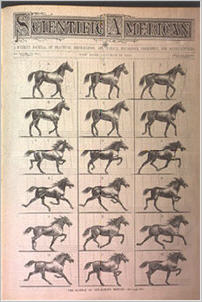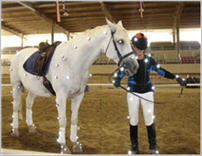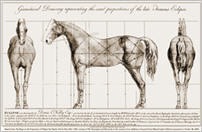Background
Introduction |
Biomechanics |
Equine Biomechanics |
Affiliated Results
|
Equine Biomechanics solved an age-old
equine mystery.
What is EB and what mystery was solved?
|
Equine Biomechanics
Introduction
In our last article we discussed the science of biomechanics, and how advanced technology tools like high speed video and computer modeling are playing an important role in the field -- especially to those biomechanical applications involving athletic performance.
Overview
Equine biomechanics is the study of biomechanics as it applies to horses. Many of the same uses are found in equine biomechanics as are found in human biomechanics. Many of the same techniques are also used, including digital video and computer modeling.
History of Modern Equine Biomechanics
Modern equine biomechanics probably started with Eadweard Muybridge's work at Stanford University between 1877-1878. The entire story gets very involved, but here is the short version.
|
Muybridge was hired by Leland Stanford, the Stanford University benefactor, who had decided to challenge a common belief at the time (late 19th century) that when a horse trots at least one foot is on the ground at all times. Stanford thought that all feet left the ground at one point in the cycle.
To solve the problem Muybridge improved on a recent invention in speed photography developed by John D. Isaacs (who developed the capability to film in quick sequence) and set out to photograph one of Stanford's horses trotting. The results showed that all four feet did leave the ground, a finding which gave Stanford credibility as a horse man and also put Muybridge on the map in the area of speed photography.
Muybridge's success brought him national and international fame. Scientific American, and others, published articles about his work, and his breakthroughs unwittingly started the motion picture industry.
|

"The Science of the Horse's Motions"
Scientific American, October 19, 1878
Graphic reproduction
|
Unfortunately Stanford and Muybridge had a falling out with lengthy legal battles. Leland Stanford commissioned an analysis of the pictures which Muybridge had taken, and the resulting analysis plus photos were published in a book called "The Horse in Motion", but Muybridge was not given credit in the book for his work.
For more details on this interesting story, we reference "Leland Stanford" by George T. Clark [Stanford University Press, 1931], the chapter entitled "Animal Locomotion and Muybridge.".
Equine biomechanics has evolved significantly since Muybridge's days, and currently impacts several fields in equine management, including injury prevention and treatment, performance enhancement, and spans several equine sports.
Injury Prevention and Treatment
Equine biomechanics has several applications in the area of injury prevention and treatment development. A study in Japan highlights one such effort.
"It is well known that laminitis and tendinitis causes considerable impediment to racing by horses, and if abnormal racing form could be defined and applied clinically, it would contribute to the early detection and early treatment of these diseases. In this research, we used a high-speed camera and computed analysis of racing form, with the aim of defining running styles based on limb movement and establishing the basis of a system for detecting abnormal motion." The article went on to mention that as a result they had developed a technique and apparatus for the early detection of laminitis and other locomotive disorders. Please visit this site for more information on this topic.
Performance Management
The picture shows a horse being prepped for a dressage run which will be videoed and then used in a biomechanical analysis.
|

|
Dressage was one of the first equine sports areas to adopt the technology of biomechanics for enhancing sports performance.
Show jumping is another area that has adopted these approaches where both horse and rider are videoed to provide input and feedback.
|
But the subject most interesting to us is the application of biomechanics to thoroughbreds.
For hundreds of years people have been asking "what is it that makes one horse run faster than another". This question is at the heart of biomechanics as applied to thoroughbreds. Biomechanics as applied to thoroughbred performance focuses mainly on the biological fuel system and the mechanical systems.
Important gait differences occur in time intervals impossible to see with the naked eye, or even with regular video.
|
|
The field of equine biomechanics is using high speed video to film thoroughbred horses at racing speeds and have begun using this as the basis for detailed gait analysis which examines stride length; energy usage; leg angles; shoulder, neck and joint positions; hoof movement patterns, etc..
|

|
It also looks at the relative positions of the limbs at each phase of the stride and the timing of each hoof placement. This kind of detailed analysis would simply be impossible with the naked eye, and is enabling new insights into the understanding of why one horse runs faster than another.
A company called Equix Biomechanics, a Case The Race affiliated company, has been a leader in this technology for many years and has produced award winning results in the process.
Conclusion
Biomechanics has many of the same applications to equine interests as it does for human interests. Equine biomechanics has a long history, starting over 100 years ago. The current version of equine biomechanics uses very advanced technologies including high speed video and computer modeling to produce increasingly interesting and relevant insights into equine performance and in particular why one thoroughbred can run faster than another.
Next Time
Next time we look at the affiliated results obtained at sister companies to Case The Race using closely related technologies.
|
|
|
 |
|
DRF Past Performances
It all starts with the PPs! A wealth of information packed into a small space. Download your PP, take a pass at your selections, then lay CASE next to it to validate your picks and look for unfound value!
|
FREE Membership
|
Register now and receive these benefits FREE.
- Make selections and track your results on your favorite tracks.
- Free CASE report every Sunday.
- Email alerts.
- Access to CASE search.
- Member-only specials and promotions.
|
NFL Combine
The NFL uses comparable measures of athleticism during an annual review of the years' draft picks called the NFL Combines.
see the video
|


